HotFix: Game Balance
 World of Warships' gameplay constantly changes and evolves. New ships are introduced, the game mechanics are updated, and players come up with new tactics.
World of Warships' gameplay constantly changes and evolves. New ships are introduced, the game mechanics are updated, and players come up with new tactics.To keep the game interesting and battles fair, it is extremely important to maintain balance in this ever-changing sea of game mechanics, new content, and creative playstyles. In today's article, we're going to tell you how the game balance in World of Warships is created and dispel several popular myths.
[previewyoutube][/previewyoutube] [hr][/hr]
[h2]What Is Balance?[/h2]
First of all, we need to define what balance is, since the concept of balance can vary across different games.
For us, balance is a set of actions aimed at keeping the game process interesting:
- In general, the game should be interesting for both the players themselves and those who play with and against them.
- Each battle should bring different gameplay, even if a person plays the same ship in a hundred battles in a row.
To achieve this, it's important for each player to have an equal opportunity to affect the battle outcome, regardless of the ship they choose to helm into battle. For example, if a ship is too strong, playing against her will be unpleasant and commanding the ship will also get boring pretty quickly. Moreover, a strong ship will likely become very popular by virtue of its effectiveness and thus reduce the diversity in battles.
[hr][/hr]
[h2]Statistics, Feedback, and Decision Making[/h2]
The primary difficulty in maintaining the game balance is the fact that each player may perceive fairness and balance differently, depending on their experience and understanding of game mechanics and the situation in a specific battle. Each player has their own favorite and hated ships, ship types, and playstyles.
Since our game has a wide audience, there are numerous opinions about the game balance and how it should work. It is only natural that these opinions can differ very strongly and even contradict each other.
At the same time, we, as developers, consider it to be very important to help the game evolve in a balanced way and take the majority opinion of our players into account. To create a new feature or make a change and then evaluate the results and plan the next actions, we need to process all these opinions and see the big picture. Next, we need to compare them with what happens in battle and make a decision. We need statistics for analysis.
Statistics can be divided into two main components:
- The first is the opinion of players that we obtain from various surveys and the feedback that we collect via different platforms.
- Battle statistics—various data gathered from battle results.
Feedback from players is extremely important to us, and we are infinitely grateful for your involvement and for helping us improve the game. However, our project is very complex, and it grows even more complex with each new release. To find the cause of player dissatisfaction, we often need to solve a huge tangle of interconnections and sometimes arrive at a solution in a completely different area. In other words, the "pain point" itself is not always the place you need to change something.
Statistics and data analysis hold a special place in our work. They are quite powerful tools, but they are the most difficult to use at the same time. We have the ability to collect a huge amount of data about everything that happens in the game, but collecting data is only the tip of the iceberg—you also need to process and analyze it. Since there are so many interconnections in the game and they are so complex, making decisions based on statistics becomes quite a challenging task. At the same time, the consequences of decisions made about some aspects of the game can have unpredictable effects on others.
For example, Update 0.7.5 saw the introduction of the "Hit Hard! Hit Fast! Hit Often!" campaign, which comprised numerous missions that could be completed playing only American ships—cruisers, in particular. This led to a dramatic increase in the popularity of American cruisers, and their distinctive feature is the Surveillance Radar consumable. This had a significant impact on destroyer gameplay.
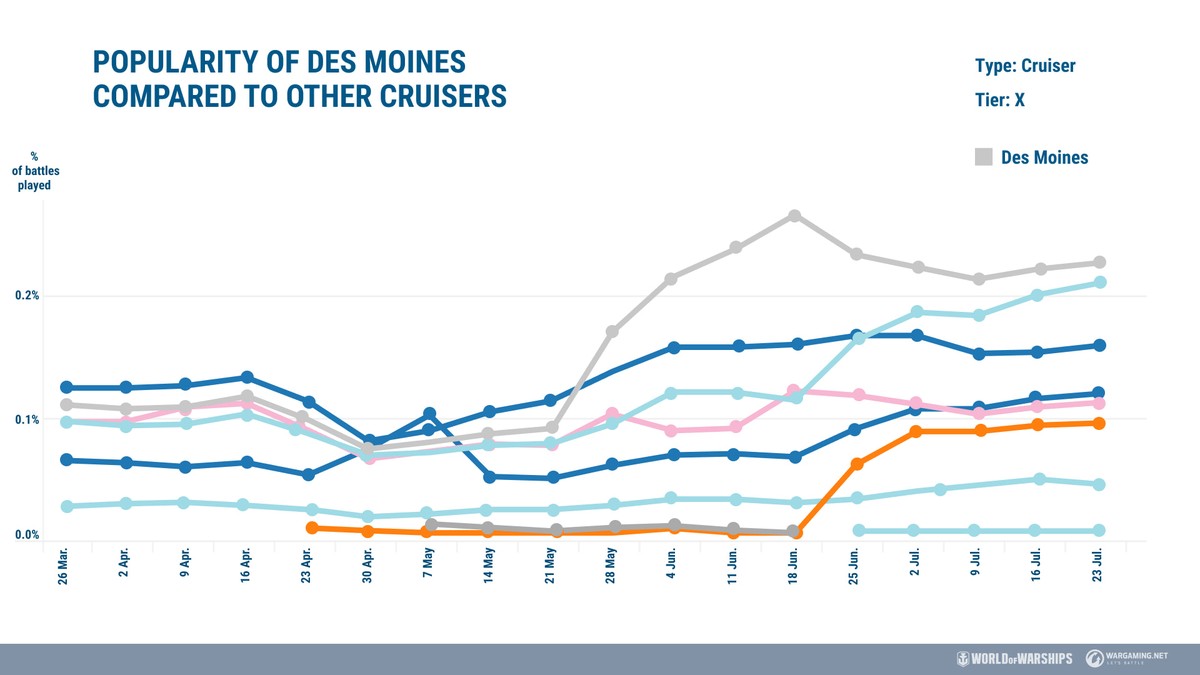
[h2]Working with Data When Making Decisions[/h2]
As we mentioned earlier, statistics are an important tool for tuning the balance in any game. This is because many interactions in the game are largely random and unpredictable within a single battle or series of battles.
For example, how do you estimate how much damage a battleship receives from torpedoes? In one battle it may not encounter a destroyer because they were on different flanks; in another battle, there may be no destroyers at all. We can give a ton of examples like this. In other words, it's impossible to analyze something on the basis of a single event. To understand how things actually are, you need quite a large sample of battles. Collecting various metrics and analyzing them helps us fine-tune interactions in the game in a much more efficient way than by doing it only on the basis of our own expert appraisal and player feedback.
It is quite obvious that the more data we collect, the higher the load on our servers is and the more difficult the data processing will be. In many ways, analysis of metrics in the game is a process that naturally evolves as the game develops and new ships, mechanics, modes, and other components are added to it.
Just a couple of years ago, we had quite a modest toolset for game balance at our disposal. For example, we used certain average indicators of ship efficiency without dividing players by skill level. Of course, we understood that all people play differently, but we had no idea to what extent.
It happened because we used far fewer metrics than now, and at that time, we had relatively modest server capacity to gather and process them. However, our game grew and became more complex. While the simpler methods of ship balance were generally enough at that time, as our game grew and the variety of game factors and unique gameplay types increased, so did the requirements for ship balancing tools.
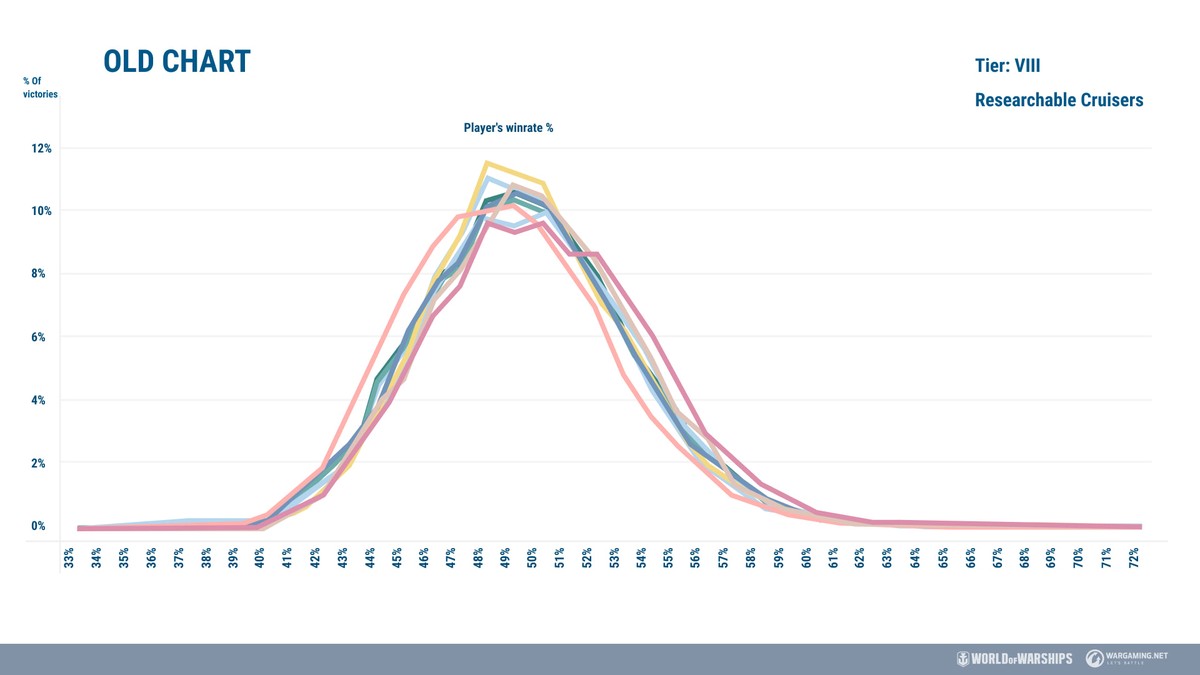

Now, we gather significantly more information as our game grows. Apart from that, our approach to evaluating ship efficiency also changed. For example, if we speak about ship efficiency, we don't just evaluate average values now, but also consider the experience and skill levels of players, peak and average values, and we take how these values are distributed over time into account. We used this approach for almost all main metrics: a ship's winrate, damage, relative damage, survival time in battle, and many others.
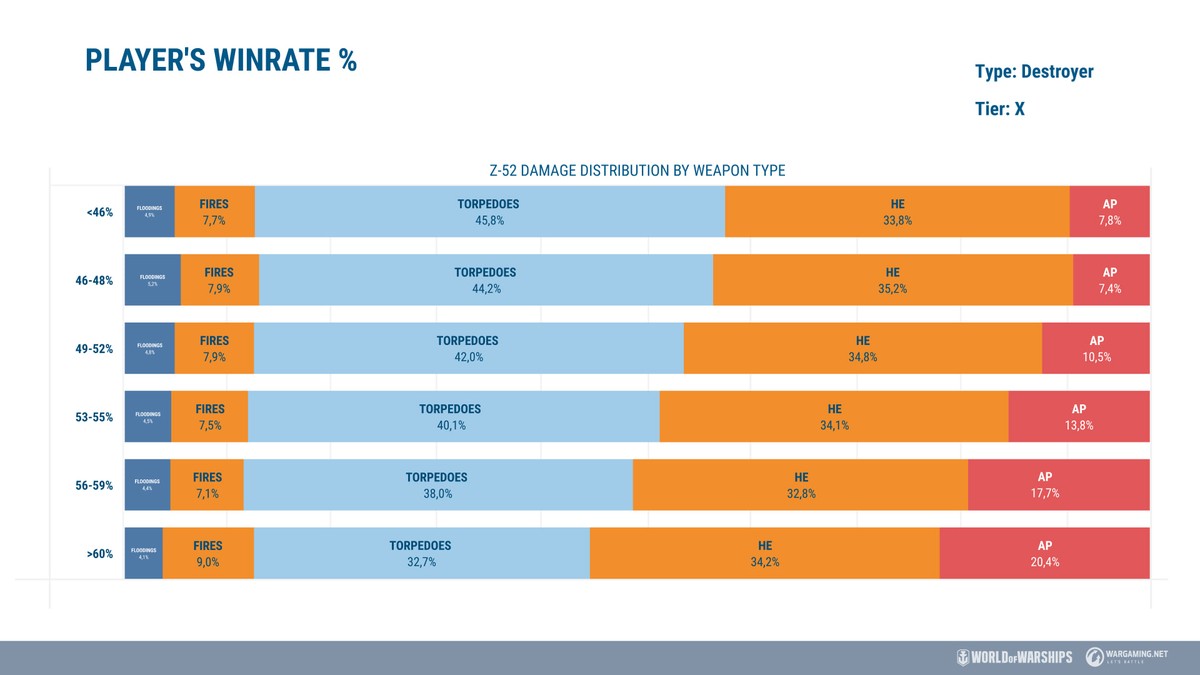
Apart from that, we now have more experience in planning data analysis. For example, from the very beginning of submarine testing, we were able to receive a significant volume of a variety of detailed data, whether it was how long submarines spent in each state, how many times they hit with sonar pings, or how much damage their torpedoes dealt to different targets.
And we could look at all this data for different groups of players. This allowed us to make decisions faster and better.
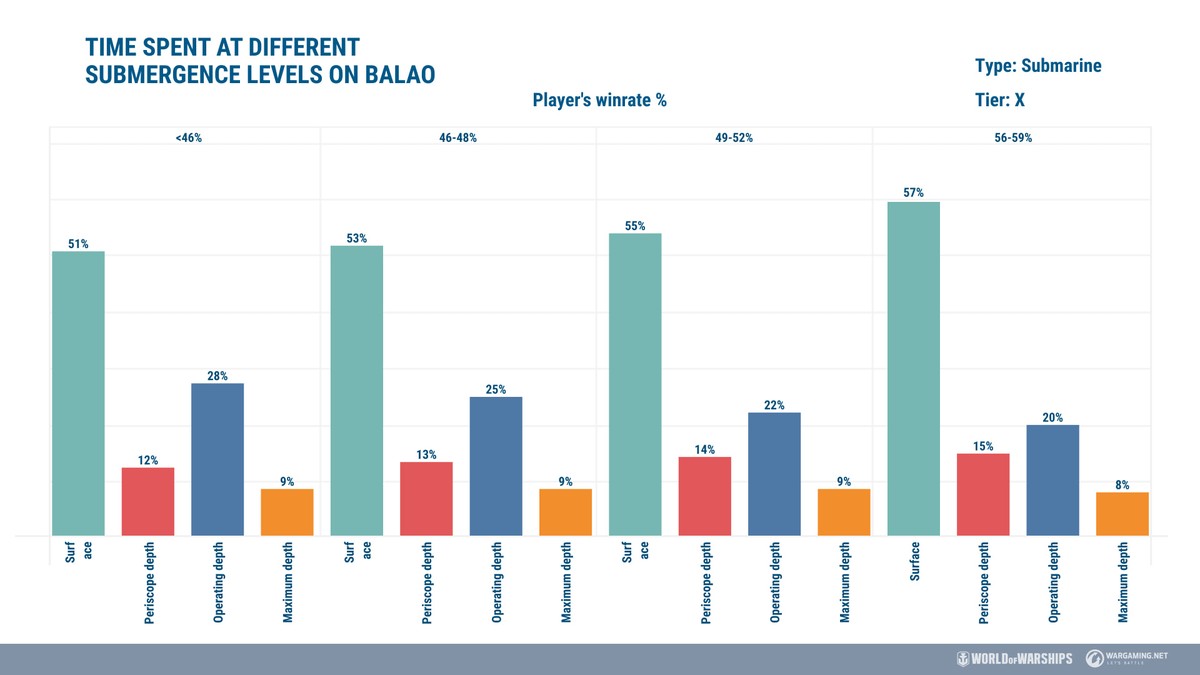

Of course, there were mistakes. The Italian battleship branch is one such example. At the time of its release, the ships were weaker than their counterparts in terms of combat efficiency. As a result, their efficiency had to be brought to normal values across several subsequent updates.
Statistics is pure mathematics, but dry numbers always hide player experience, and some interconnections can be lost or invisible after mathematical processing. Therefore, you always need to keep in mind that numbers are not the whole truth when working with statistics. No matter how much we want to calculate everything as accurately as possible, statistics are not omnipotent, and there is always room for data interpretation.
[h2]How Decisions Are Made[/h2]
Apart from the dry numbers of statistics, we also take guidance from the feedback from our players and use our own judgment. In other words, you need to consider a combination of three factors to make an informed decision: statistics + player feedback + developer experience. Based on these three pillars, we can be sure that a decision we make is in the best interests of the game.
[h3]MYTH The developers don't play their game.[/h3]
In fact, the developers play their game all the time. This is especially true for the Balance Department, whose employees simply must be aware of what is happening in real battles. The developers must play their game to enhance their firsthand knowledge, which allows us to resolve possible conflicts between player opinions and their results. We don't just play a lot on the Live Server, but also on test servers and on various local development servers. In addition, we spend a significant amount of time playing test ships and in various battle modes.
[expand]
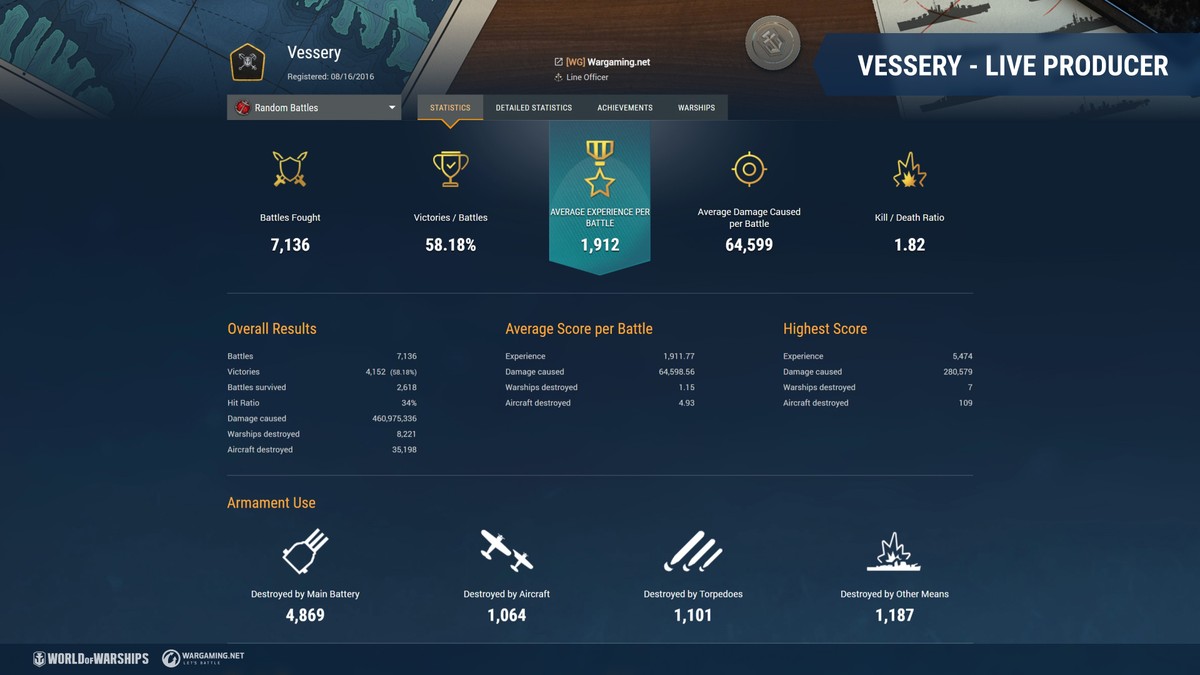
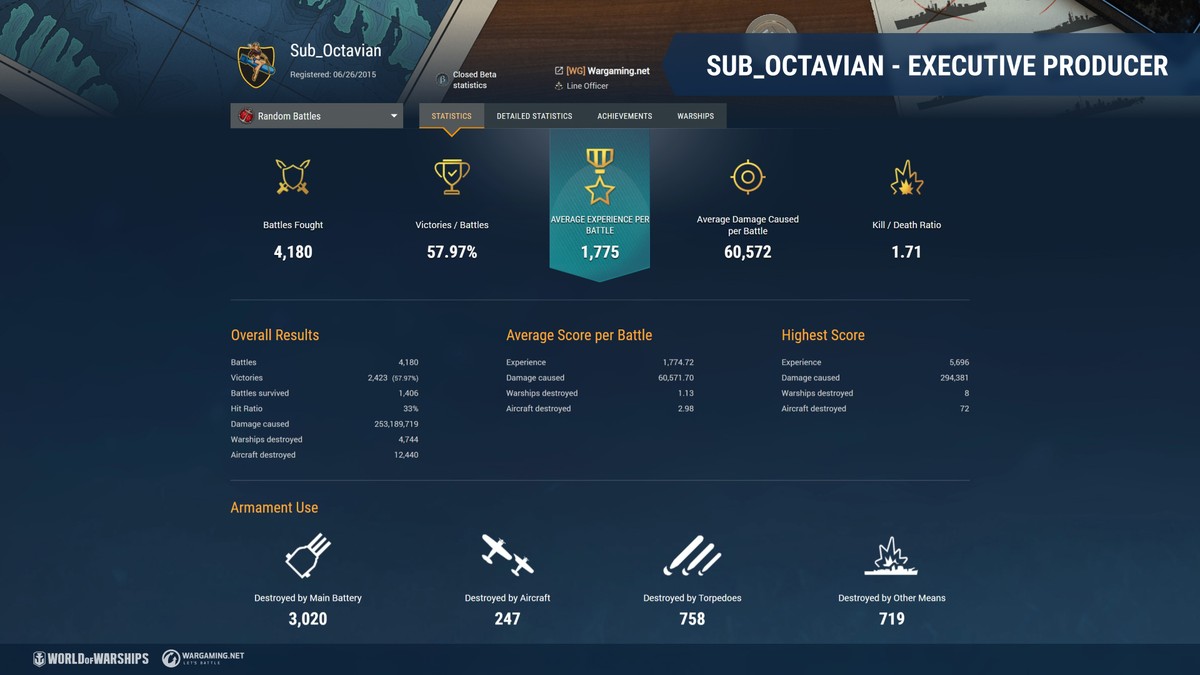
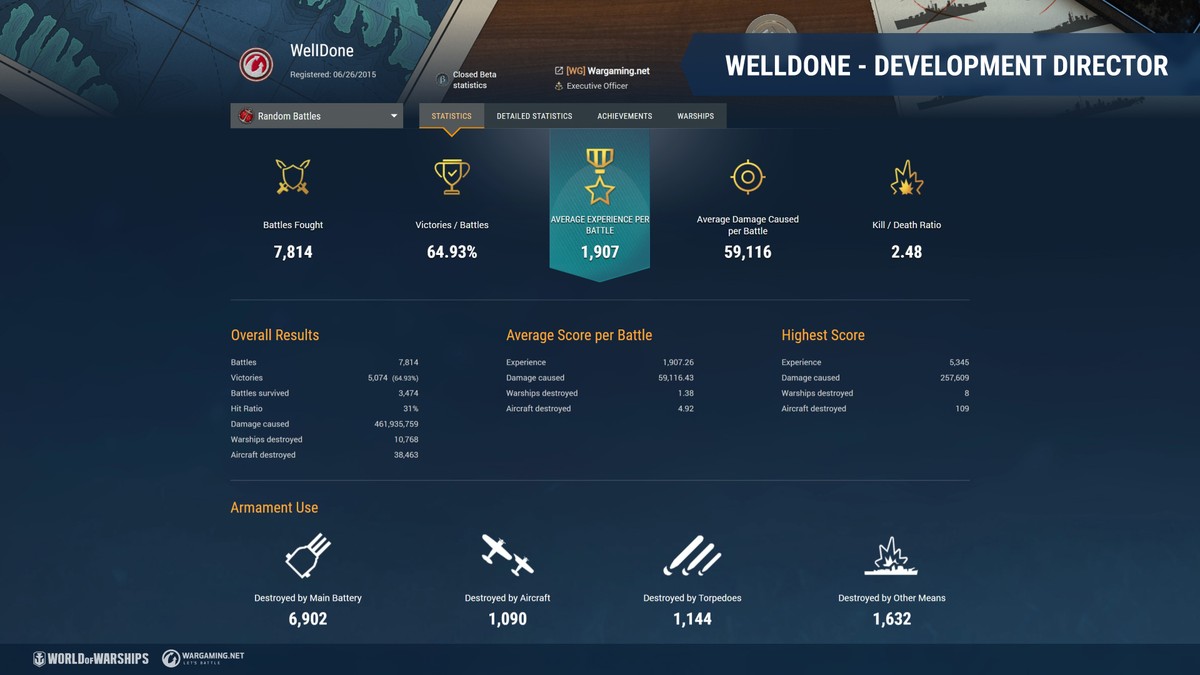
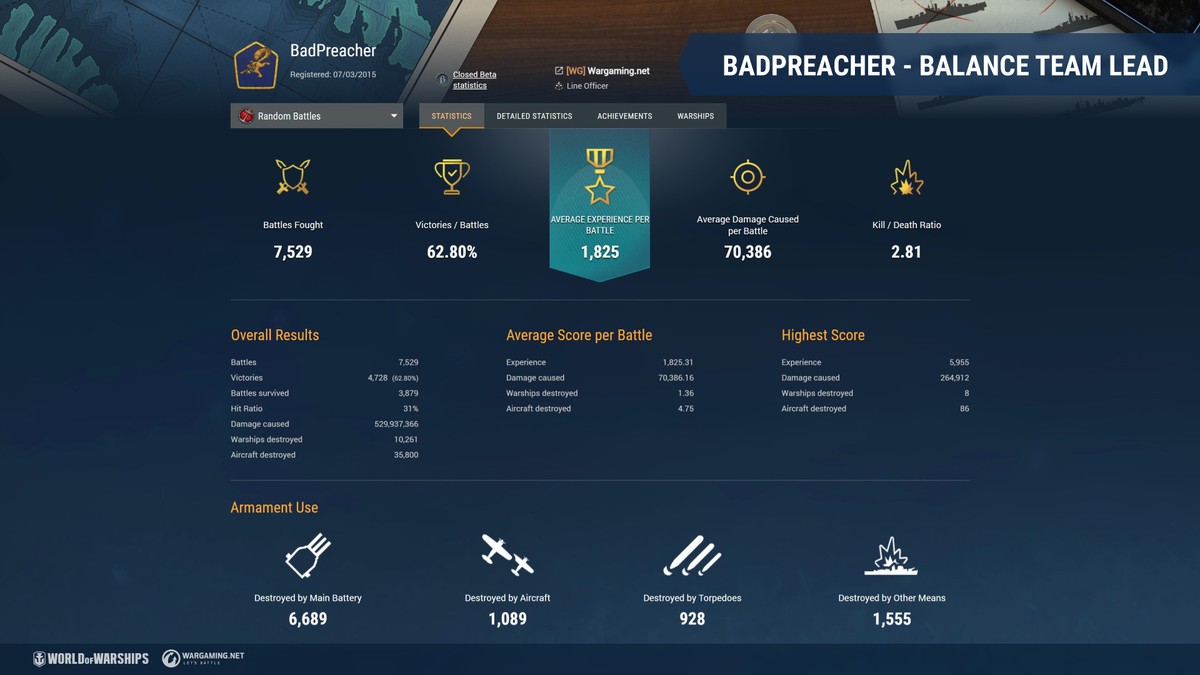
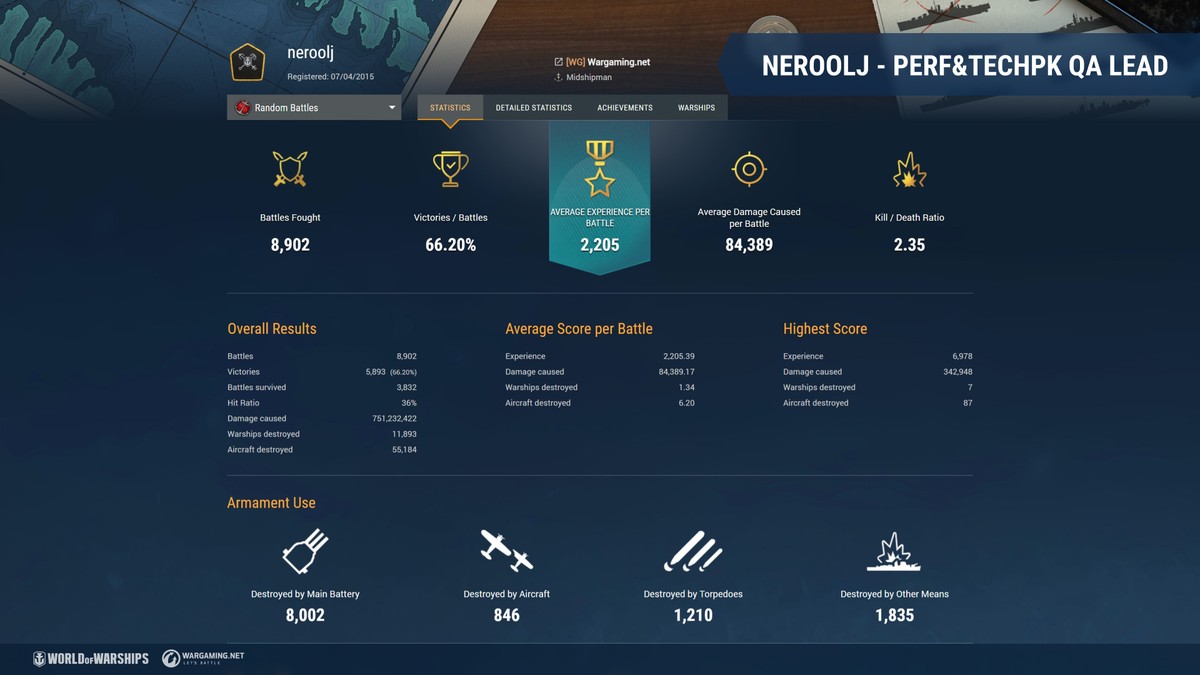

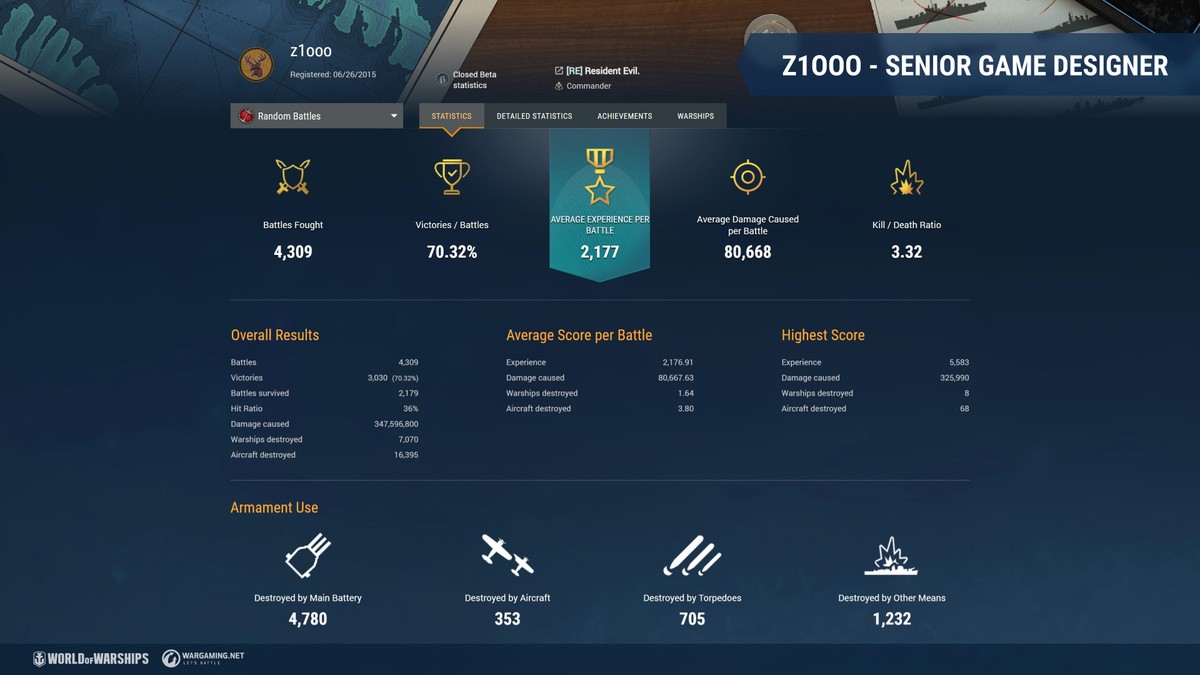
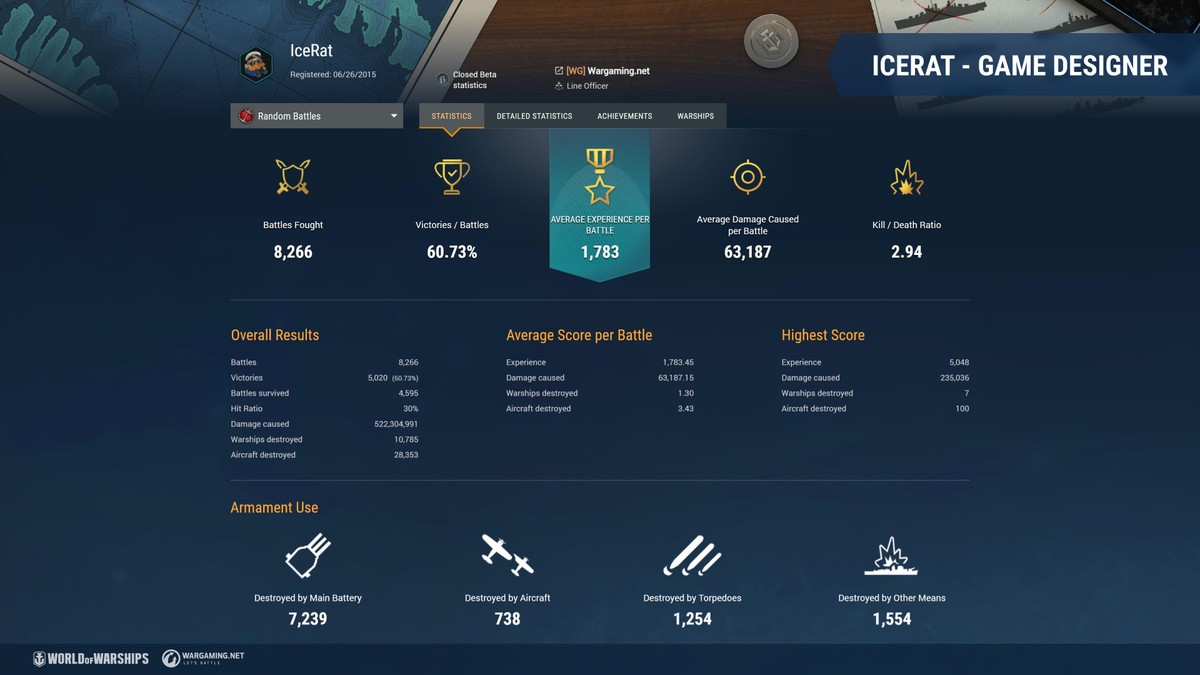 [/expand]
[/expand]Thus, when making a decision, we have to analyze a large volume of data, apart from the feedback itself. Because of this, some players have the impression that we do not pay attention to their feedback, which of course is not true.
- Creating balance in World of Warships is not a confrontation between players and developers, but a form of close cooperation. We draw the ideas for many of our solutions from suggestions put forward by our players.
For example, when adding anti-submarine weapons to ships in the game, we initially decided to give them only to some of the branches so that these would become a new "national" gameplay feature. On paper, players were not happy about this idea. However, even ideas that players do not initially like still need to be tested, since the result may turn out to be quite positive in the end. For example, players did not like the concept of destroyers without smoke generators or torpedo tubes when they first appeared, but in the end, the idea turned out to be successful and these ships found their niche and gameplay. In the case of anti-submarine weapons, however, the test results confirmed player opinions. For this reason, we added anti-submarine weapons to the majority of cruisers and battleships in the game.
Any change to the game balance, be it weakening a ship, strengthening it, or adding new mechanics, affects almost every aspect of battle gameplay and also affects the game experience for both the ship's owner and other players. For this reason, when changing the game balance, we try to find a solution that will benefit both the majority of players and the game in general.
It is not always possible to find such a solution right away, and sometimes it is necessary to wait until it appears. We always keep the unresolved "pains" of our players at the forefront of our mind and work on solving them.
A good example of a long but successful search for a solution to a balancing problem is the story of battleship

Therefore, we decided to withdraw her from sale. Unfortunately, the diminishing popularity of the ship did not solve the problem. Players suggested numerous ways to resolve the issue—decrease her rate of fire, reduce her accuracy, or weaken her HE shells. However, detailed analysis of the statistics and player feedback on
- A mid-range

 X Thunderer that used both AP and HE shells.
X Thunderer that used both AP and HE shells. - A long-range

 X Thunderer that exclusively used HE shells.
X Thunderer that exclusively used HE shells.
Players did not have any problems with the first playstyle, so we did not want to weaken the ship for all of her owners at once.
The solution was found in reducing her firing range. This did not affect the players who fought at medium range, but it significantly changed the gameplay for those who liked firing HE shells from long distances—they had to either change their playstyle or mount an upgrade that increases the range of fire at the expense of rate of fire.
Conversely, our decisions sometimes feel sudden for players. It could be the case that a ship that has shown good performance over many updates and brought joy to players, or vice versa, a ship that has long been considered not very effective, suddenly undergoes balance changes when she hasn't undergone any before.
Game balance is not set in stone. New ships and mechanics are constantly appearing; the ways in which players approach the game are changing; and a ship that did not require any changes before, since she was normal in terms of her characteristics, can move beyond the limits of her battle effectiveness. In this case, we must make adjustments.
For example, recent statistics showed that old-timers in our game, such as
We're also trying to stick to our strategy of making only small changes. This helps us not to change ships too much in a single take and carefully bring them to the required efficiency level, and to do it all without making sudden moves and without hurting the game experience.
[hr][/hr]
[h2]Development of New Branches[/h2]
Returning to statistics, it is worth noting that they can be extremely useful when creating new ship concepts. For example,
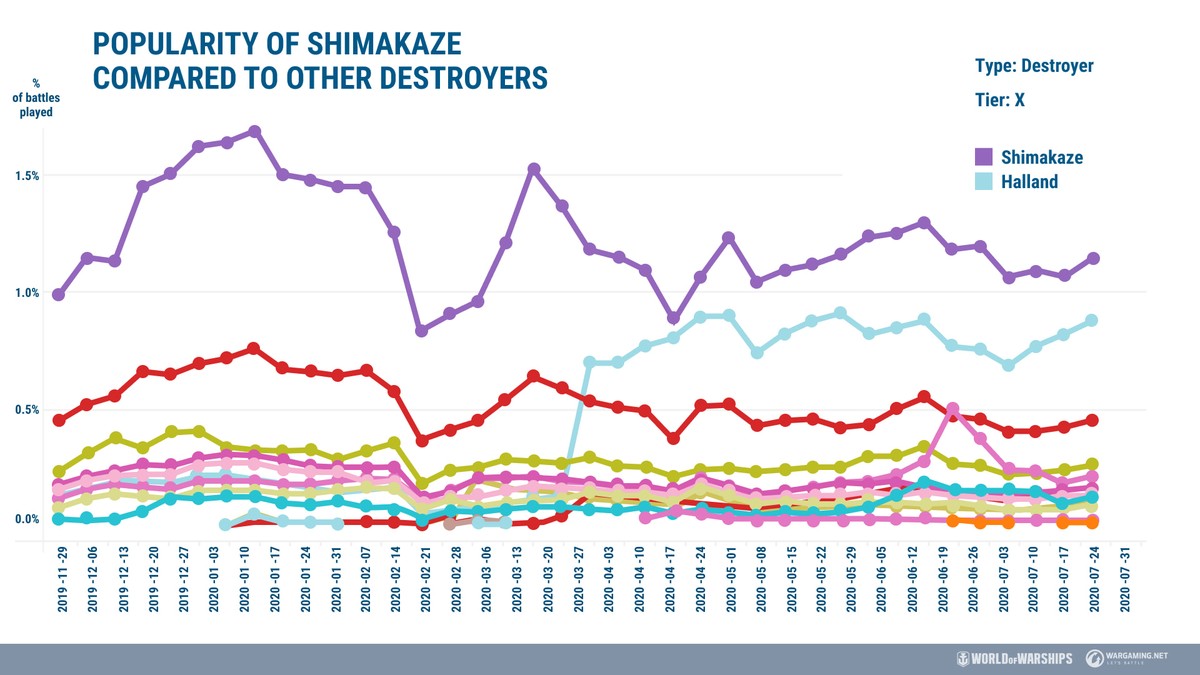
When adding a new branch of German destroyers, we analyzed the roles played by destroyers in battle based on data on damage caused, Key Area capture, spotting, interaction with other ship types, etc. We came to the conclusion that our game lacked destroyers that deal significant damage to cruisers. This is how the German destroyers were born, and they cause about a third of their total damage to cruisers.
At the same time, players often criticize us for creating new ships exclusively around "gimmicks," i.e. prominent features in the stats or equipment of a ship, such as Airstrike on Dutch cruisers.
However, these prominent and strong features make a ship unique, and as we mentioned earlier, one of our tasks is to maintain diversity in the game. If we keep making similar ships, this will quickly lead to stagnated gameplay and players will get bored.
For the same reason, we do not make ships that are too strong. Players will immediately understand what ship is the easiest to win on, and it will eventually lead to a decrease in the overall enjoyment of the game, both for those who play the ship, because they will quickly get tired of winning without effort, and for those who play against her. In addition, this will greatly increase the popularity of a ship and will also negatively affect game diversity. At the same time, it is very important for the uniqueness of a new ship to be the key to preserving the uniqueness of the old ships.
[h3]MYTH: The developers give preference to particular nations when creating and balancing ships.[/h3]
Just based on the development objectives, it is not beneficial for us to create a bias toward any nation—this would violate the principle of variability in the game and ultimately lead to ship imbalance and deterioration of the game experience. From the perspective of simple logic, for us—the development team—there is simply no reason to give preference to any nation because the whole game is our brainchild and all the ships in it are valuable and loved by us. We do our best to develop the game in a balanced and even way, and any particular preferences contradict this task.
[h2]How Ships Are Tested[/h2]
Ships arrive in testing after the initial set-up and trial runs by the development team.
Next, they fall into the hands of supertesters and involved Clan players, as well as Community Contributors and other volunteer groups. They help us a lot with testing, and we thank them for their help.
- We would like to express our gratitude to participants of the Clan and super tests—you contribution is very important, and your help is invaluable. Thank you!
During testing, we don't look at the ship's balance. We first check the feedback from players to see whether they like this ship or not.

When we receive the survey results, we act in one of two ways:
- Keep the current concept and begin balancing the ship to bring it to the required efficiency.
- Completely abandon the concept and do something else.
When we move to fine-tuning the ship, we pick specific facts from the player feedback about what they liked and disliked about the ship:
- If a ship needs to be weakened, we try to "cut" the unnecessary things but preserve the ship's concept.
- If a ship is not effective enough, we look at what test participants disliked the most and work with those aspects of the ship. However, it should be noted that not all weak points of a ship need to be fixed because the uniqueness of a ship lies not only in its strengths but also in its weaknesses.
Unlike ships that have already appeared on the Live Server, quite drastic and significant balance changes can be applied to test ships. There are two reasons for this: First, these ships are not available to regular players, so their experience will not be affected by drastic changes to test ships. Second, if we make a decision to apply significant changes to a test ship, there is no need to implement them carefully and in stages, since this will significantly extend the testing of this ship and slow down its arrival to the Live Server.
After passing the closed test, most ships are tested on the Live Server. This stage is extremely important because it allows us to test the ship in real combat conditions.
This approach to testing often raises questions from our players, who believe that ships should be tested on separate servers. Unfortunately, no closed testing can create the same environment and provide the same volume of data as the Live Server.
Moreover, on the Live Server, we test not only the ship settings, but also the concept: how players perceive her in battle—both the owners of the ship and those who play against her. This allows us to fine-tune the ship balance, anticipate possible difficulties, and make the necessary adjustments even before the ship is released.
At the same time, on the Live Server, we don't only test individual ships, we also test new ship types, concepts, and mechanics—for example, submarines or superships. Testing them on the Live Server is quite an important process because it allows us to better prepare them for full-fledged introduction to the game and avoid repeating the mistakes we made with the aircraft carrier overhaul in Update 0.8.0, when insufficient testing led to a long period of changes, including several major fixes soon after the update's release.
[h3]MYTH: The developers do not consider player feedback about test ships.[/h3]
We listen to player feedback about test ships very carefully, and we base ship concepts on this feedback.
[h2]Ship Type Balance and the "Rock, Paper, Scissors" Principle[/h2]
At the moment, we are trying to balance ships according to the "Rock, Paper, Scissors" principle—a particular ship type is effective against some ship types and vulnerable to others.
The reason for this is that the game features over 400 ships, and it is very difficult to remember the specifics of each of them. To keep things simple, all ships in our game fall under five types: battleships, cruisers, submarines, destroyers, and aircraft carriers.
The "Rock, Paper, Scissors" principle allows players to understand how they should play their ship type, what strengths and weaknesses it has, what its role in battle is, and what interaction principles with other ship types exist.
Knowing this information, a player will not be confused in battle, even if they have little experience. It helps define in general terms their tasks in battle, how they should act while playing the selected ship of a particular type, what ship types are their primary targets, and who will target their ship first of all.
The "Rock, Paper, Scissors" principle also improves gameplay variability—each ship type will be in demand in battle because each can be effective against ships of another type, and, at the same time, each has its own counter-class.
Moreover, there are also differences between ships of the same type, and these become obvious to players once they gain a certain amount of experience in the game. For example, there are artillery destroyers, torpedo destroyers, ships that fight for Key Areas, those that engage enemies over long distances, etc. In other words, ships of one type may have different purposes in battle, and you will need to play them differently according to their purpose. These differences are more complex and subtle because the boundaries between the different kinds of ships are not always obvious. However, the more experienced a player grows, the clearer these limits become and the more knowledge they will have about how to use their ship in battle based on her strengths.
Working on balance is an ongoing process aimed at maintaining old mechanics and introducing new content. The balance team is currently focused on submarines and superships—they create gameplay for them and for those who play against them. We do not forget about old ships and possible changes for them either. We strive to make adjustments for them as unnoticeable and painless as possible for players. Our goal is to provide each player with the opportunity to find their own gameplay, creating sufficient diversity in the game. At the same time, we want all players to have equal opportunities to apply their abilities in battle.
- We hope that our article helped you learn how balance works in World of Warships, which is largely created thanks to your feedback and the battles you fight.